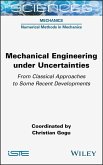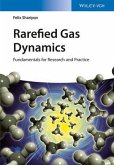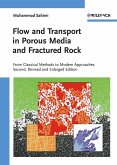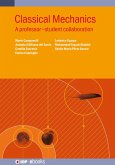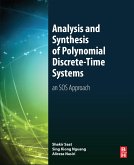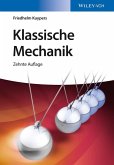Mechanical Engineering in Uncertainties From Classical Approaches to Some Recent Developments (eBook, ePUB)
Redaktion: Gogu, Christian
139,99 €
139,99 €
inkl. MwSt.
Sofort per Download lieferbar

0 °P sammeln
139,99 €
Als Download kaufen

139,99 €
inkl. MwSt.
Sofort per Download lieferbar

0 °P sammeln
Jetzt verschenken
Alle Infos zum eBook verschenken
139,99 €
inkl. MwSt.
Sofort per Download lieferbar
Alle Infos zum eBook verschenken

0 °P sammeln
Mechanical Engineering in Uncertainties From Classical Approaches to Some Recent Developments (eBook, ePUB)
Redaktion: Gogu, Christian
- Format: ePub
- Merkliste
- Auf die Merkliste
- Bewerten Bewerten
- Teilen
- Produkt teilen
- Produkterinnerung
- Produkterinnerung

Bitte loggen Sie sich zunächst in Ihr Kundenkonto ein oder registrieren Sie sich bei
bücher.de, um das eBook-Abo tolino select nutzen zu können.
Hier können Sie sich einloggen
Hier können Sie sich einloggen
Sie sind bereits eingeloggt. Klicken Sie auf 2. tolino select Abo, um fortzufahren.

Bitte loggen Sie sich zunächst in Ihr Kundenkonto ein oder registrieren Sie sich bei bücher.de, um das eBook-Abo tolino select nutzen zu können.
Considering the uncertainties in mechanical engineering in order to improve the performance of future products or systems is becoming a competitive advantage, sometimes even a necessity, when seeking to guarantee an increasingly high safety requirement. Mechanical Engineering in Uncertainties deals with modeling, quantification and propagation of uncertainties. It also examines how to take into account uncertainties through reliability analyses and optimization under uncertainty. The spectrum of the methods presented ranges from classical approaches to more recent developments and advanced…mehr
- Geräte: eReader
- mit Kopierschutz
- eBook Hilfe
- Größe: 11.68MB
Andere Kunden interessierten sich auch für
![Mechanical Engineering in Uncertainties From Classical Approaches to Some Recent Developments (eBook, PDF) Mechanical Engineering in Uncertainties From Classical Approaches to Some Recent Developments (eBook, PDF)]() Mechanical Engineering in Uncertainties From Classical Approaches to Some Recent Developments (eBook, PDF)139,99 €
Mechanical Engineering in Uncertainties From Classical Approaches to Some Recent Developments (eBook, PDF)139,99 €![Rarefied Gas Dynamics (eBook, ePUB) Rarefied Gas Dynamics (eBook, ePUB)]() Felix SharipovRarefied Gas Dynamics (eBook, ePUB)120,99 €
Felix SharipovRarefied Gas Dynamics (eBook, ePUB)120,99 €![Flow and Transport in Porous Media and Fractured Rock (eBook, ePUB) Flow and Transport in Porous Media and Fractured Rock (eBook, ePUB)]() Muhammad SahimiFlow and Transport in Porous Media and Fractured Rock (eBook, ePUB)171,99 €
Muhammad SahimiFlow and Transport in Porous Media and Fractured Rock (eBook, ePUB)171,99 €![Classical Mechanics (eBook, ePUB) Classical Mechanics (eBook, ePUB)]() Classical Mechanics (eBook, ePUB)46,95 €
Classical Mechanics (eBook, ePUB)46,95 €![Analysis and Synthesis of Polynomial Discrete-Time Systems (eBook, ePUB) Analysis and Synthesis of Polynomial Discrete-Time Systems (eBook, ePUB)]() Mohd Shakir Md SaatAnalysis and Synthesis of Polynomial Discrete-Time Systems (eBook, ePUB)79,95 €
Mohd Shakir Md SaatAnalysis and Synthesis of Polynomial Discrete-Time Systems (eBook, ePUB)79,95 €![Security and Resilience in Intelligent Data-Centric Systems and Communication Networks (eBook, ePUB) Security and Resilience in Intelligent Data-Centric Systems and Communication Networks (eBook, ePUB)]() Security and Resilience in Intelligent Data-Centric Systems and Communication Networks (eBook, ePUB)87,95 €
Security and Resilience in Intelligent Data-Centric Systems and Communication Networks (eBook, ePUB)87,95 €![Klassische Mechanik (eBook, ePUB) Klassische Mechanik (eBook, ePUB)]() Friedhelm KuypersKlassische Mechanik (eBook, ePUB)49,99 €
Friedhelm KuypersKlassische Mechanik (eBook, ePUB)49,99 €-
-
-
Considering the uncertainties in mechanical engineering in order to improve the performance of future products or systems is becoming a competitive advantage, sometimes even a necessity, when seeking to guarantee an increasingly high safety requirement. Mechanical Engineering in Uncertainties deals with modeling, quantification and propagation of uncertainties. It also examines how to take into account uncertainties through reliability analyses and optimization under uncertainty. The spectrum of the methods presented ranges from classical approaches to more recent developments and advanced methods. The methodologies are illustrated by concrete examples in various fields of mechanics (civil engineering, mechanical engineering and fluid mechanics). This book is intended for both (young) researchers and engineers interested in the treatment of uncertainties in mechanical engineering.
Dieser Download kann aus rechtlichen Gründen nur mit Rechnungsadresse in D ausgeliefert werden.
Produktdetails
- Produktdetails
- Verlag: John Wiley & Sons
- Erscheinungstermin: 1. April 2021
- Englisch
- ISBN-13: 9781119817611
- Artikelnr.: 61442882
- Verlag: John Wiley & Sons
- Erscheinungstermin: 1. April 2021
- Englisch
- ISBN-13: 9781119817611
- Artikelnr.: 61442882
- Herstellerkennzeichnung Die Herstellerinformationen sind derzeit nicht verfügbar.
Christian Gogu is Associate Professor at the University Toulouse III-Paul Sabatier, France. His research, which he carries out at the Clément Ader Institute, focuses, in particular, on taking into account uncertainties in the design and optimization of aeronautical systems.
Foreword xi
Maurice LEMAIRE
Preface xv
Christian GOGU
Part 1. Modeling, Propagation and Quantification of Uncertainties 1
Chapter 1. Uncertainty Modeling 3
Christian GOGU
1.1. Introduction 3
1.2. The usefulness of separating epistemic uncertainty from aleatory uncertainty 6
1.3. Probability theory 10
1.3.1. Theoretical context 10
1.3.2. Probabilistic approach for modeling aleatory uncertainties 13
1.3.3. Probabilistic approach for modeling epistemic uncertainties 16
1.4. Probability box theory (p-boxes) 21
1.5. Interval analysis 24
1.6. Fuzzy set theory 25
1.7. Possibility theory 27
1.7.1. Theoretical context 27
1.7.2. Comparison between probability theory and possibility theory 30
1.7.3. Rules for combining possibility distributions 34
1.8. Evidence theory 35
1.8.1. Theoretical context 35
1.8.2. Rules for combining belief mass functions 38
1.9. Evaluation of epistemic uncertainty modeling 40
1.10. References 40
Chapter 2. Microstructure Modeling and Characterization 43
François WILLOT
2.1. Introduction 43
2.2. Probabilistic characterization of microstructures 45
2.2.1. Random sets 45
2.2.2. Covariance 47
2.2.3. Granulometry 50
2.2.4. Minkowski functionals 51
2.2.5. Stereology 53
2.2.6. Linear erosion 53
2.2.7. Representative volume element 54
2.3. Point processes 55
2.3.1. Homogeneous Poisson point processes 56
2.3.2. Inhomogeneous Poisson point processes 58
2.4. Boolean models 59
2.4.1. Definition and Choquet capacity 59
2.4.2. Properties 61
2.4.3. Covariance 63
2.4.4. Other characteristics 63
2.5. RSA models 66
2.6. Random tessellations 67
2.6.1. Voronoi tessellation 68
2.6.2. Johnson-Mehl tessellation 69
2.6.3. Laguerre tessellation 69
2.6.4. Random Poisson tessellation 70
2.6.5. The dead-leaves model 71
2.6.6. Generalized random partition models 72
2.7. Gaussian fields 73
2.8. Conclusion 76
2.9. Acknowledgments 77
2.10. References 77
Chapter 3. Uncertainty Propagation at the Scale of Aging Civil Engineering Structures 83
David BOUHJITI, Julien BAROTH and Frédéric DUFOUR
3.1. Introduction 83
3.2. Problem positioning 85
3.2.1. Probabilistic formulation 85
3.2.2. Thermo-hydro-mechanical-leakage transfer function 86
3.2.3. Resulting probabilistic THM-F problem 87
3.3. Random field-based modeling of material properties 88
3.3.1. Random fields 88
3.3.2. Generation methods for discretized random fields 88
3.3.3. Random fields and autocorrelations 91
3.3.4. Application: contribution to modeling the cracking of reinforced concrete works by self-correlated r.f 92
3.4. Modeling uncertainty propagation using response surface methods 98
3.4.1. Probabilistic coupling strategies 98
3.4.2. Polynomial chaos method 101
3.5. Conclusion 108
3.6. References 108
Chapter 4. Reduction of Uncertainties in Multidisciplinary Analysis Based on a Polynomial Chaos Sensitivity Study 113
Sylvain DUBREUIL, Nathalie BARTOLI, Christian GOGU and Thierry LEFEBVRE
4.1. Introduction 113
4.2. MDA with model uncertainty 115
4.2.1. Formalism 115
4.2.2. Solving the random MDA 119
4.2.3. Approximation of the quantity
Maurice LEMAIRE
Preface xv
Christian GOGU
Part 1. Modeling, Propagation and Quantification of Uncertainties 1
Chapter 1. Uncertainty Modeling 3
Christian GOGU
1.1. Introduction 3
1.2. The usefulness of separating epistemic uncertainty from aleatory uncertainty 6
1.3. Probability theory 10
1.3.1. Theoretical context 10
1.3.2. Probabilistic approach for modeling aleatory uncertainties 13
1.3.3. Probabilistic approach for modeling epistemic uncertainties 16
1.4. Probability box theory (p-boxes) 21
1.5. Interval analysis 24
1.6. Fuzzy set theory 25
1.7. Possibility theory 27
1.7.1. Theoretical context 27
1.7.2. Comparison between probability theory and possibility theory 30
1.7.3. Rules for combining possibility distributions 34
1.8. Evidence theory 35
1.8.1. Theoretical context 35
1.8.2. Rules for combining belief mass functions 38
1.9. Evaluation of epistemic uncertainty modeling 40
1.10. References 40
Chapter 2. Microstructure Modeling and Characterization 43
François WILLOT
2.1. Introduction 43
2.2. Probabilistic characterization of microstructures 45
2.2.1. Random sets 45
2.2.2. Covariance 47
2.2.3. Granulometry 50
2.2.4. Minkowski functionals 51
2.2.5. Stereology 53
2.2.6. Linear erosion 53
2.2.7. Representative volume element 54
2.3. Point processes 55
2.3.1. Homogeneous Poisson point processes 56
2.3.2. Inhomogeneous Poisson point processes 58
2.4. Boolean models 59
2.4.1. Definition and Choquet capacity 59
2.4.2. Properties 61
2.4.3. Covariance 63
2.4.4. Other characteristics 63
2.5. RSA models 66
2.6. Random tessellations 67
2.6.1. Voronoi tessellation 68
2.6.2. Johnson-Mehl tessellation 69
2.6.3. Laguerre tessellation 69
2.6.4. Random Poisson tessellation 70
2.6.5. The dead-leaves model 71
2.6.6. Generalized random partition models 72
2.7. Gaussian fields 73
2.8. Conclusion 76
2.9. Acknowledgments 77
2.10. References 77
Chapter 3. Uncertainty Propagation at the Scale of Aging Civil Engineering Structures 83
David BOUHJITI, Julien BAROTH and Frédéric DUFOUR
3.1. Introduction 83
3.2. Problem positioning 85
3.2.1. Probabilistic formulation 85
3.2.2. Thermo-hydro-mechanical-leakage transfer function 86
3.2.3. Resulting probabilistic THM-F problem 87
3.3. Random field-based modeling of material properties 88
3.3.1. Random fields 88
3.3.2. Generation methods for discretized random fields 88
3.3.3. Random fields and autocorrelations 91
3.3.4. Application: contribution to modeling the cracking of reinforced concrete works by self-correlated r.f 92
3.4. Modeling uncertainty propagation using response surface methods 98
3.4.1. Probabilistic coupling strategies 98
3.4.2. Polynomial chaos method 101
3.5. Conclusion 108
3.6. References 108
Chapter 4. Reduction of Uncertainties in Multidisciplinary Analysis Based on a Polynomial Chaos Sensitivity Study 113
Sylvain DUBREUIL, Nathalie BARTOLI, Christian GOGU and Thierry LEFEBVRE
4.1. Introduction 113
4.2. MDA with model uncertainty 115
4.2.1. Formalism 115
4.2.2. Solving the random MDA 119
4.2.3. Approximation of the quantity
Foreword xi
Maurice LEMAIRE
Preface xv
Christian GOGU
Part 1. Modeling, Propagation and Quantification of Uncertainties 1
Chapter 1. Uncertainty Modeling 3
Christian GOGU
1.1. Introduction 3
1.2. The usefulness of separating epistemic uncertainty from aleatory uncertainty 6
1.3. Probability theory 10
1.3.1. Theoretical context 10
1.3.2. Probabilistic approach for modeling aleatory uncertainties 13
1.3.3. Probabilistic approach for modeling epistemic uncertainties 16
1.4. Probability box theory (p-boxes) 21
1.5. Interval analysis 24
1.6. Fuzzy set theory 25
1.7. Possibility theory 27
1.7.1. Theoretical context 27
1.7.2. Comparison between probability theory and possibility theory 30
1.7.3. Rules for combining possibility distributions 34
1.8. Evidence theory 35
1.8.1. Theoretical context 35
1.8.2. Rules for combining belief mass functions 38
1.9. Evaluation of epistemic uncertainty modeling 40
1.10. References 40
Chapter 2. Microstructure Modeling and Characterization 43
François WILLOT
2.1. Introduction 43
2.2. Probabilistic characterization of microstructures 45
2.2.1. Random sets 45
2.2.2. Covariance 47
2.2.3. Granulometry 50
2.2.4. Minkowski functionals 51
2.2.5. Stereology 53
2.2.6. Linear erosion 53
2.2.7. Representative volume element 54
2.3. Point processes 55
2.3.1. Homogeneous Poisson point processes 56
2.3.2. Inhomogeneous Poisson point processes 58
2.4. Boolean models 59
2.4.1. Definition and Choquet capacity 59
2.4.2. Properties 61
2.4.3. Covariance 63
2.4.4. Other characteristics 63
2.5. RSA models 66
2.6. Random tessellations 67
2.6.1. Voronoi tessellation 68
2.6.2. Johnson-Mehl tessellation 69
2.6.3. Laguerre tessellation 69
2.6.4. Random Poisson tessellation 70
2.6.5. The dead-leaves model 71
2.6.6. Generalized random partition models 72
2.7. Gaussian fields 73
2.8. Conclusion 76
2.9. Acknowledgments 77
2.10. References 77
Chapter 3. Uncertainty Propagation at the Scale of Aging Civil Engineering Structures 83
David BOUHJITI, Julien BAROTH and Frédéric DUFOUR
3.1. Introduction 83
3.2. Problem positioning 85
3.2.1. Probabilistic formulation 85
3.2.2. Thermo-hydro-mechanical-leakage transfer function 86
3.2.3. Resulting probabilistic THM-F problem 87
3.3. Random field-based modeling of material properties 88
3.3.1. Random fields 88
3.3.2. Generation methods for discretized random fields 88
3.3.3. Random fields and autocorrelations 91
3.3.4. Application: contribution to modeling the cracking of reinforced concrete works by self-correlated r.f 92
3.4. Modeling uncertainty propagation using response surface methods 98
3.4.1. Probabilistic coupling strategies 98
3.4.2. Polynomial chaos method 101
3.5. Conclusion 108
3.6. References 108
Chapter 4. Reduction of Uncertainties in Multidisciplinary Analysis Based on a Polynomial Chaos Sensitivity Study 113
Sylvain DUBREUIL, Nathalie BARTOLI, Christian GOGU and Thierry LEFEBVRE
4.1. Introduction 113
4.2. MDA with model uncertainty 115
4.2.1. Formalism 115
4.2.2. Solving the random MDA 119
4.2.3. Approximation of the quantity
Maurice LEMAIRE
Preface xv
Christian GOGU
Part 1. Modeling, Propagation and Quantification of Uncertainties 1
Chapter 1. Uncertainty Modeling 3
Christian GOGU
1.1. Introduction 3
1.2. The usefulness of separating epistemic uncertainty from aleatory uncertainty 6
1.3. Probability theory 10
1.3.1. Theoretical context 10
1.3.2. Probabilistic approach for modeling aleatory uncertainties 13
1.3.3. Probabilistic approach for modeling epistemic uncertainties 16
1.4. Probability box theory (p-boxes) 21
1.5. Interval analysis 24
1.6. Fuzzy set theory 25
1.7. Possibility theory 27
1.7.1. Theoretical context 27
1.7.2. Comparison between probability theory and possibility theory 30
1.7.3. Rules for combining possibility distributions 34
1.8. Evidence theory 35
1.8.1. Theoretical context 35
1.8.2. Rules for combining belief mass functions 38
1.9. Evaluation of epistemic uncertainty modeling 40
1.10. References 40
Chapter 2. Microstructure Modeling and Characterization 43
François WILLOT
2.1. Introduction 43
2.2. Probabilistic characterization of microstructures 45
2.2.1. Random sets 45
2.2.2. Covariance 47
2.2.3. Granulometry 50
2.2.4. Minkowski functionals 51
2.2.5. Stereology 53
2.2.6. Linear erosion 53
2.2.7. Representative volume element 54
2.3. Point processes 55
2.3.1. Homogeneous Poisson point processes 56
2.3.2. Inhomogeneous Poisson point processes 58
2.4. Boolean models 59
2.4.1. Definition and Choquet capacity 59
2.4.2. Properties 61
2.4.3. Covariance 63
2.4.4. Other characteristics 63
2.5. RSA models 66
2.6. Random tessellations 67
2.6.1. Voronoi tessellation 68
2.6.2. Johnson-Mehl tessellation 69
2.6.3. Laguerre tessellation 69
2.6.4. Random Poisson tessellation 70
2.6.5. The dead-leaves model 71
2.6.6. Generalized random partition models 72
2.7. Gaussian fields 73
2.8. Conclusion 76
2.9. Acknowledgments 77
2.10. References 77
Chapter 3. Uncertainty Propagation at the Scale of Aging Civil Engineering Structures 83
David BOUHJITI, Julien BAROTH and Frédéric DUFOUR
3.1. Introduction 83
3.2. Problem positioning 85
3.2.1. Probabilistic formulation 85
3.2.2. Thermo-hydro-mechanical-leakage transfer function 86
3.2.3. Resulting probabilistic THM-F problem 87
3.3. Random field-based modeling of material properties 88
3.3.1. Random fields 88
3.3.2. Generation methods for discretized random fields 88
3.3.3. Random fields and autocorrelations 91
3.3.4. Application: contribution to modeling the cracking of reinforced concrete works by self-correlated r.f 92
3.4. Modeling uncertainty propagation using response surface methods 98
3.4.1. Probabilistic coupling strategies 98
3.4.2. Polynomial chaos method 101
3.5. Conclusion 108
3.6. References 108
Chapter 4. Reduction of Uncertainties in Multidisciplinary Analysis Based on a Polynomial Chaos Sensitivity Study 113
Sylvain DUBREUIL, Nathalie BARTOLI, Christian GOGU and Thierry LEFEBVRE
4.1. Introduction 113
4.2. MDA with model uncertainty 115
4.2.1. Formalism 115
4.2.2. Solving the random MDA 119
4.2.3. Approximation of the quantity

